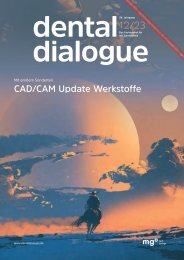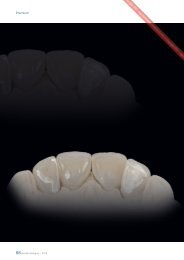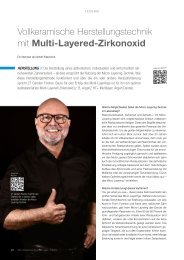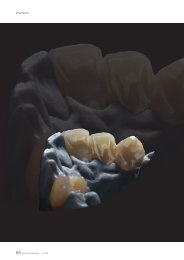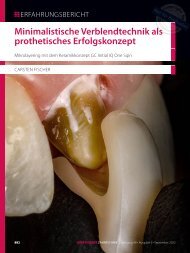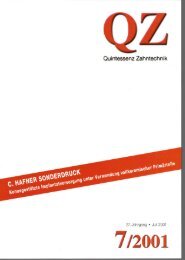Create successful ePaper yourself
Turn your PDF publications into a flip-book with our unique Google optimized e-Paper software.
A minimalistic<br />
veneering technique<br />
as prosthetic<br />
success concept<br />
Microlayering with<br />
the GC Initial IQ ONE SQIN<br />
ceramic concept<br />
by ZT Carsten Fischer, Germany<br />
First publication Quintessenz Zahntechnik 9/22. Adapted with author’s permission.<br />
ZT Carsten Fischer graduated as a dental<br />
technician in 1992, following his father’s<br />
footsteps. In 2007, he founded Sirius ceramics,<br />
a specialised laboratory for all-ceramic<br />
restorations and implantology, in Frankfurt/<br />
Main (Germany). He is considered one of<br />
Germany’s all-ceramic specialists. He is the<br />
founder of the Panther machining protocol,<br />
the Finevo cleaning protocol and is a<br />
consultant for the development of zirconia<br />
materials. Passionate about his job, he<br />
focuses on CAD/CAM technologies and all<br />
ceramic restorations on teeth and implants<br />
and has a strong connection with industry<br />
and educational partners. Since 1994, he is<br />
a consultant for various companies in the<br />
dental industry and involved in product<br />
development and from 2012 to 2014, he was<br />
employed at the department for postgraduate<br />
education department at the University of<br />
Frankfurt. Carsten Fischer is a lecturer at<br />
Steinbeis University, Berlin, a lecturer at DIU/<br />
Dresden International University and<br />
speaker for various organizations (DGI) and<br />
on the board of EADT.<br />
“What you see is what you get” – this small sentence<br />
describes the great advantage of micro-layering. While<br />
the conventional layering technique requires a great<br />
deal of experience in order to replicate a natural tooth<br />
in terms of shape, function and colour, the framework<br />
determines the basic parameters with micro-layering.<br />
About 80 to 90 percent of the restoration shape is<br />
already defined with this technique, so one can fully<br />
concentrate on the fine layer of veneering ceramics.<br />
This way of working enables a high-quality result and at<br />
the same time has a positive influence on the everyday<br />
work in the dental laboratory. After all, while dental<br />
technology is changing, one thing remains the same:<br />
the need for qualitative products and work.<br />
The discussion as to whether the same<br />
good aesthetics can be achieved in this<br />
way as with classic layering technology<br />
is useless. Micro-layering (Figs. 1-5) is<br />
an alternative approach that offers great<br />
potential for many dental laboratories<br />
thanks to new processing technologies<br />
and modern materials science.<br />
Classical ceramic layering is an artistry<br />
1<br />
that works excellently and can lead to<br />
great results. But it requires well-founded<br />
know-how, a lot of experience and<br />
usually a high expenditure of time.<br />
And since hardly anyone is a natural<br />
talent, the dental technician has to<br />
work hard and disciplined for years to<br />
fully master it. New ways such as<br />
micro-layering are a welcome alternative.
Turnaround in all-ceramics<br />
1<br />
2<br />
Micro-layering was born out of the<br />
need to improve the aesthetics of<br />
monolithic restorations. Modern<br />
zirconium oxide restorations have<br />
been produced for more than 10 years<br />
and are considered state of the art.<br />
Clinical experience and scientific<br />
studies confirm their long-term stability.<br />
Especially with the advent of multilayered<br />
zirconium oxides, many dental<br />
laboratories have integrated monolithic<br />
restorations into their everyday<br />
laboratory life in order to avoid chipping<br />
of the significantly less strong veneering<br />
ceramics. The aesthetic finalization is<br />
based on the multichromatic zirconium<br />
oxide and, if necessary, a colour<br />
refinement with ceramic paint or<br />
micro-veneering takes place.<br />
Fig. 1 and 2: Three crowns in the molar area, implemented with micro-layering technology.<br />
The functional surfaces of the crowns are monolithically designed.<br />
This all-ceramic course change led to<br />
safe and efficient restoration concepts.<br />
Rapid improvements in the field of<br />
hardware and software have opened<br />
up new possibilities for realizing even<br />
complex patient situations with the<br />
help of a full-fledged, virtual simulation<br />
(virtual articulation, face scan,<br />
complete chewing and joint data<br />
acquisition, etc.).<br />
Basically, the application of a thin<br />
veneering layer is not new. What is new,<br />
however, are the especially designed<br />
ceramic materials (such as the ONE<br />
SQIN colour-and-form ceramic concept)<br />
and the microlayering ‘principles’:<br />
• Veneering only in the visible area<br />
• Use of specialized characterization<br />
with 3D-effect<br />
• Internal staining + micro-thin<br />
ceramic layer (0.1-0.6 mm)<br />
opalescence. Certainly, it is theoretically<br />
possible to try the new concept with<br />
old products. In practice, however, it<br />
seems necessary to rely on modern<br />
materials, especially designed to<br />
enable minimalist ways to refine a<br />
restoration.<br />
The company GC (Tokyo, Japan) was<br />
already focusing on veneering<br />
reduction more than ten years ago.<br />
At that time, the basic recipe was laid<br />
for what is now offered by many<br />
manufacturers as micro-layering. The<br />
focus of years of research was how the<br />
3 4<br />
laborious ceramic veneering could be<br />
reduced without aesthetic compromises.<br />
In the beginning, for example, there<br />
were the IQ-Concepts “Press Over<br />
Metal” and “Press Over Zirconia” as<br />
well as the “One Body Concept”. The<br />
first 3D glaze paints, the Initial Lustre<br />
Pastes (GC), were launched in 2007,<br />
followed by Lustre Pastes NF in 2010.<br />
These developments formed the basis<br />
for the all-ceramic colour-and-form<br />
concept GC Initial IQ ONE SQIN (Figs.<br />
6-10), a result of experience and<br />
modern materials technology.<br />
In order to meet the optical challenges<br />
of aesthetic veneering in such thin<br />
layers, special ceramic products are<br />
required, whose colouring is based on<br />
the classic layer masses in terms of<br />
colour value, fluorescence and<br />
5<br />
Fig. 3-5: Partial veneering resembling classic<br />
veneering with the colour-and-form concept<br />
GC Initial IQ ONE SQIN; here using the<br />
example of a single anterior crown.<br />
2
6<br />
7<br />
8<br />
Fig. 6: Working example of an all-ceramic<br />
crown for the lateral anterior tooth 12 (GC<br />
Initial IQ ONE SQIN): zirconium oxide scaffold<br />
(ArgenZ HT+ ML).<br />
Fig. 7: Framework preparation (Lustre Pastes).<br />
9<br />
Fig. 8: Thin veneering layer.<br />
10<br />
Modern materials science<br />
as a basis<br />
Materials science has laid the<br />
foundation for contemporary<br />
prosthetic work. Accordingly, basic<br />
knowledge is imperative. New<br />
developments should be observed<br />
with interest and critically questioned<br />
using a high professional standard.<br />
Often, the feedback from everyday<br />
laboratory life makes successful<br />
materials and products what they are<br />
today. The author of this article has<br />
always been actively involved in<br />
development processes and<br />
contributes a lot to new concepts and<br />
procedures with his experience and<br />
expertise. The ONE SQIN concept is<br />
an example hereof.<br />
The ONE SQIN concept<br />
at a glance<br />
The ONE SQIN system is based on<br />
past experience and focuses on the<br />
challenges of today. The set consists<br />
of coordinated ceramic masses, all of<br />
which can be combined with each<br />
other. It can be used on the one hand<br />
for purely monolithic, superficial<br />
applications and on the other hand<br />
for high-end aesthetics with internal<br />
characterization. Aesthetic refinement<br />
is then done with a paper thin<br />
(0.1-0.6 mm) veneering layer with<br />
specialized feldspar ceramics.<br />
The 3D-ceramic paints Initial IQ Lustre<br />
Pastes ONE are used to characterise<br />
the framework, providing natural<br />
Fig. 9 and 10: Finished crown: buccal and lateral view.<br />
light-optical properties (fluorescence,<br />
opalescence) and also take over the<br />
connection function for the ceramic<br />
micro-layer (Fig 11).<br />
With the feldspar-based microlayering<br />
ceramic Initial IQ SQIN, the morphology<br />
and surface texture are in turn<br />
determined (Fig. 12). Initial Spectrum<br />
Stains are universal “2D-paints” for<br />
individual characteristics (Fig. 13).<br />
Depending on the need, the optimal<br />
workflow is selected. Very helpful are<br />
the versatility and the compatibility<br />
with which the individual components<br />
can be used and mixed with each<br />
other. The multitude of possibilities is<br />
therefore almost unlimited in order to<br />
do justice to a high-quality,<br />
sophisticated aesthetic result.<br />
11<br />
Fig. 11: The GC Initial IQ ONE SQIN system<br />
includes Lustre Pastes (paintable ceramic<br />
masses) for internal colouring (e.g. fluorescence),<br />
which omit the connection firing for the<br />
connection between the framework and<br />
ceramic.<br />
12<br />
Fig. 12: A special Form-and-Texture liquid<br />
gives the ceramic an almost plastic consistency,<br />
the high stability enables targeted shaping.<br />
13<br />
Fig. 13: External colouring for individual<br />
surface characterization.<br />
The benefits<br />
Micro-layering is considered an<br />
alternative to conventional layering.<br />
From the point of view of the laboratory<br />
owner as well as the dental technician,<br />
it has many interesting advantages.<br />
The process is efficient without having<br />
to accept compromises in quality. In<br />
addition, it ensures a satisfying,<br />
reproducible workflow, which leads<br />
3
to a good result with comparatively<br />
high certainty. Functional contact<br />
surfaces as well as approximate contacts<br />
are defined by the framework and<br />
this simplifies the aesthetic finalization<br />
many times over (Fig. 14). Especially less<br />
experienced dental technicians get<br />
the opportunity to deliver high-quality<br />
work and can thus be categorised in a<br />
good salary structure. This increases the<br />
attractiveness of dental work and is at<br />
the same time motivating for career<br />
starters. They can actively participate<br />
in the all-ceramic day-to-day business,<br />
for example by producing all-ceramic<br />
posterior tooth restorations almost<br />
independently. In addition, in the case<br />
of considerable aesthetic challenges<br />
(anterior tooth area), the framework<br />
can be prepared by less experienced<br />
ceramists; the ceramic specialist only<br />
has to devote himself to characterization<br />
and finalization.<br />
14<br />
Fig. 14: The design created in the software<br />
could be converted 1:1 into ceramic. The<br />
vestibular surfaces are veneered with a paper<br />
thin ceramic layer.<br />
Zirconium oxide as a basis<br />
Basically, the success of micro-layering<br />
is inextricably linked to the quality of<br />
the colour-bearing base – the<br />
framework material.<br />
of debate is the shade selection<br />
method for ML zirconium oxide. In<br />
the field of shade selection, a turning<br />
point has been observed for some<br />
time. The classic monochrome Vita<br />
shade guide has only limited<br />
significance. It has served well in<br />
dental technology for decades and<br />
for a long time offered a good<br />
communicative basis – partially<br />
error-prone, but nevertheless it was<br />
very helpful. Now the system has<br />
reached it well-deserved retirement<br />
and can respectfully retreat.<br />
Although an A3 will always remain an<br />
A3, the reproduction of the shade<br />
based on the shade-providing<br />
framework is only possible if the<br />
shade communication is fully mastered.<br />
It is far from easy and the learning<br />
curve is steep, yet it forms the basis of<br />
a timeless all-ceramic.<br />
It is also the task of the dental industry<br />
to strive for uniformity with regard to<br />
colour determination and<br />
nomenclature. Until then, the dental<br />
laboratory can help itself with e.g. a<br />
custom shade guide from the<br />
laboratory’s own ML zirconium oxide.<br />
Practical implementation of a<br />
restoration with ONE SQIN<br />
micro-layering<br />
A validated workflow is required for<br />
the correct implementation of<br />
micro-layering. A framework milled in<br />
15<br />
wax or PMMA, which can be precisely<br />
adapted in form and function to the<br />
circumstances, defines the basis. After<br />
shade selection, the framework is<br />
milled from ML zirconium oxide. (Tip:<br />
choose a lighter shade)<br />
Framework preparation<br />
Zirconium oxide still is a sensitive<br />
material that must be treated with<br />
care. Blasting of the framework is not<br />
recommended. The author relies on a<br />
pre-polished zirconium oxide surface.<br />
Special rotating tools (Fig. 16) are used<br />
for all-ceramics (Panther Edition, Sirius<br />
Ceramics, Frankfurt). The Panther kit<br />
includes a standardized processing<br />
protocol. The ceramic surface is<br />
prepared at 7,000 to a maximum of<br />
12,000 rpm. Panther tools have very<br />
good cooling, which accommodates<br />
the ceramic’s properties. Due to their<br />
good removal performance, only a<br />
low contact pressure is required. The<br />
framework surface is gently processed<br />
without damaging the ceramic<br />
structure. No residues remain on the<br />
framework surface. The polishing is<br />
followed by cleaning the framework<br />
in an ultrasonic bath (80% ethanol).<br />
The zirconium oxide surface can also<br />
be conditioned with special plasma<br />
devices. This leads to surface<br />
activation and consequently to better<br />
surface wetting.<br />
16<br />
A multi-layered (ML) zirconium oxide<br />
framework replaces the dentine<br />
layering. Hence, the colour selection<br />
is of great importance (Fig. 15). It<br />
should be noted that most ML<br />
zirconium oxides are strongly<br />
saturated or intense in their colour<br />
saturation and often look a touch too<br />
dark. Therefore, it is advisable to always<br />
choose a slightly lighter shade. A topic<br />
Fig. 15: The framework replaces the dentine<br />
layering. Therefore, in micro-layering, the<br />
choice of framework material becomes a<br />
success criterion. Multi-layered zirconium<br />
oxides offer an ideal basis (zirconium oxide:<br />
ArgenZ HT+ ML, Argen Dental, Düsseldorf).<br />
4<br />
Fig. 16: Careful preparation is already a central<br />
process step in the unsintered green state<br />
(Panther, Sirius ceramics). Novel instruments<br />
work in a material-friendly, efficient manner and<br />
leave no unwanted residues on the material’s<br />
surface.
Internal Staining with<br />
Lustre Pastes ONE<br />
The described concept integrates the<br />
Lustre Pastes ONE. These fine-grained<br />
paintable ceramics are used for the<br />
colour design of monolithic restorations<br />
as well as the internal characterization<br />
of veneering frameworks. At the same<br />
time, they have excellent wetting<br />
properties and serve as a strong<br />
connector between the framework<br />
and veneering ceramics.<br />
The Lustre Pastes ONE are suitable for<br />
the internal and external<br />
characterization of<br />
• Zirconium oxide and lithium<br />
disilicate frameworks<br />
• Layered ceramics with a CTE<br />
between 6.9 and 13.3.<br />
The ready-to-use Lustre Pastes ONE<br />
are based on a blend of refined glass<br />
ceramic particles that ensure lifelike<br />
deep light dynamics for a natural<br />
3D-effect. In addition, all Lustre Pastes<br />
ONE are fluorescent (different levels)<br />
(Fig. 11). Thanks to their paste-like,<br />
thixotropic consistency, they are easier<br />
and more precise to apply compared<br />
to conventional stains.<br />
Veneering with SQIN<br />
The basic colour and shape are now<br />
already defined, so full attention can<br />
be paid to the light-optical subtleties<br />
and micro-texture. SQIN can be applied<br />
in layers of 0.1 to 0.6 mm. Thanks to<br />
the mixture of feldspar-based glasses,<br />
a lifelike three-dimensional effect is<br />
created that brings colour, depth and<br />
natural translucency to the restorations.<br />
The special Form-and-Texture Liquid<br />
offers good processing and modelling<br />
properties for an individual surface<br />
texture. The liquid gives the ceramic a<br />
sort of ‘plastic’ consistency: it can<br />
almost be modelled like wax. Due to<br />
its excellent shape retention, even<br />
morphological subtleties of the texture<br />
can be incorporated prior to firing<br />
(Fig. 12). Caution: the application of<br />
the Form-and-Texture Liquid should<br />
be extremely economical (one drop is<br />
enough); otherwise the mass will<br />
become too plastic and a long<br />
pre-drying will be necessary. Since the<br />
mixture of liquid and SQIN powder<br />
results in a highly compact, dense mass<br />
providing high gloss, the final glaze<br />
firing can be omitted. This self-glazing<br />
effect is unique for specialized ceramic<br />
systems and provides efficiency in the<br />
process flow.<br />
External Staining with<br />
Spectrum Stains<br />
The Spectrum Stains are universal paints,<br />
used for individual characterization<br />
and are compatible with almost any<br />
type of dental ceramic due to their<br />
large TEC range. In particular, they<br />
have been adapted to the aesthetic<br />
colour concept of GC Initial. The<br />
powder paints are available in 20<br />
shades and can be adapted to your<br />
own needs in their consistency with<br />
glaze liquid or glaze pastes. Regardless<br />
of the application method, a detailed<br />
result is achieved, which preserves the<br />
surface texture and at the same time<br />
allows an optimal gloss.<br />
Firing<br />
The thermally correct handling of<br />
zirconium oxide must be taken into<br />
account. Especially in the case of<br />
wide-span restorations, the firing<br />
curve is one of the most important<br />
parameters for a successful, long-term<br />
stable result. Only a sufficiently long<br />
drying time ensures a completed<br />
drying process. Long-term cooling<br />
must also be adhered to in order to<br />
avoid stresses within the ceramic. The<br />
bridge link with the largest volume<br />
determines the temperature rise and<br />
the cooling curve.<br />
5<br />
Other practical examples<br />
Figures 17 to 21 show the exemplary<br />
application of Initial IQ ONE SQIN for<br />
the complete restoration of an upper<br />
jaw. In addition, an anterior single<br />
crown is shown, which was finalised<br />
with the micro-layering technique<br />
and components of the ONE SQIN<br />
concept (Fig. 22 to 25).<br />
17<br />
18<br />
19<br />
20<br />
21<br />
Figs. 17-21: Challenging full-arch treatment<br />
from initial situation to end result with<br />
monolithic restorations in the posterior area<br />
and micro-layered crowns in the aesthetic<br />
anterior area. Both approaches complement<br />
each other perfectly and complete the<br />
concept idea.
Conclusion<br />
Micro-layering is an attractive<br />
alternative to classic ceramic layering.<br />
Thanks to modern materials, a high<br />
level of aesthetics can be achieved in<br />
a reproducible, efficient way, and with<br />
predictable, high precision. In<br />
combination with modern software<br />
and hardware, functional aspects can<br />
also be exactly implemented.<br />
The ONE SQIN concept is the perfect<br />
complement to this technique. The<br />
most important points are:<br />
• Minimal sinter shrinkage and wide<br />
CTE window<br />
• Optimal fluorescence with firing<br />
stability<br />
• Creation of structures and textures<br />
in the wet stage, with excellent<br />
shape retention<br />
• Self-glazing properties for time<br />
optimization<br />
• Light-optical effects are<br />
convincingly imitated, even in the<br />
thinnest of layers<br />
• Predictable results within few firings<br />
22<br />
25<br />
Fig. 22: Tooth 11 is to be supplied with a<br />
new crown.<br />
23<br />
Fig. 25: Perfect lip image.<br />
Fig. 23: The situation after removal of the old<br />
crown and light repreparation.<br />
With all these possibilities, it must not be forgotten that a really high-quality<br />
prosthetic restoration can only be created in skilled hands and with sound<br />
knowledge of materials science. Safe, valid dental procedures are always at the<br />
basis.<br />
24<br />
Fig. 24: All-ceramic crown for which a<br />
zirconium oxide framework was veneered<br />
using micro-layering (ONE SQIN).<br />
Acknowledgements<br />
The author thanks his team for their<br />
commitment and trust as well as the<br />
practice of YourSmile, Dr. Rafaela<br />
Jenatschke, for their daily willingness<br />
to support Sirius ceramics.<br />
References<br />
(Quintessenz Zahntech 2018; 44(5):<br />
652–658).<br />
6



